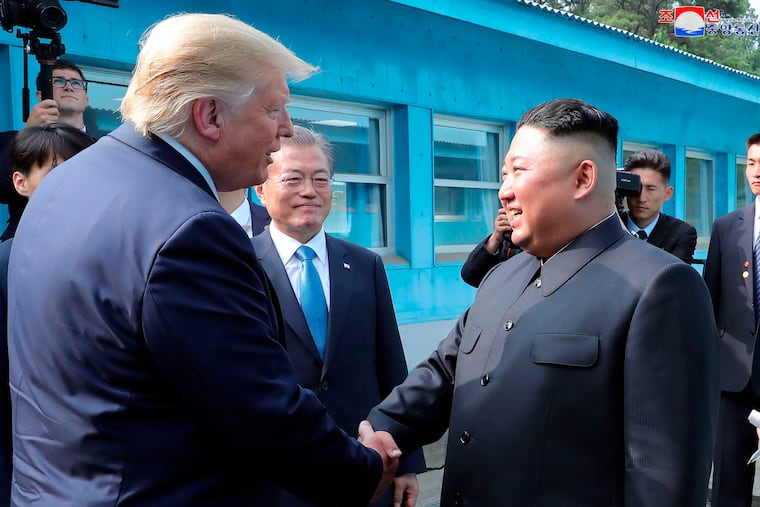Despite DMZ photo op with Kim Jong Un, Trump has made no progress on eliminating Korean nukes | Trudy Rubin
In three meetings, Kim Jong Un and Trump have yet to agree on what "denuclearization" means.

We all know how much President Donald Trump loves photo ops with strongmen. The latest was his high drama pose with Kim Jong Un, on the north side of the demilitarized zone between North and South Korea, last week.
Announced by tweet, improvised at the last minute, this move was another instance of Trump’s overtures to autocrats and dictators — on grounds that warm relationships will morph into great political deals.
If Trump’s embrace of Kim – “we fell in love,” he says -- could persuade this killer to give up his nuclear weapons, the president would indeed deserve a Nobel Peace Prize. After Trump’s first meeting with Kim, last year in Singapore, Secretary of State Mike Pompeo bragged that Kim was committed to “denuclearization” and would completely eliminate his arsenal by January 2021.
Yet in the year since the Singapore summit, there has been zero progress toward that goal. Kim’s arsenal of 30 to 60 nuclear warheads remains and more fissile material is being produced daily.
Even as Trump’s embrace transforms Kim from global pariah into international star, the North Korean makes no commitment to dismantle his weaponry. Nor has he shown much interest in serious talks. (He’s rumored to have murdered one of his chief negotiators.) He prefers to engage in fuzzy tete-a-tetes with America’s great leader.
Trump’s personal diplomacy with Kim may have tamped down the war talk that both sides were engaged in in 2017. But so far Trump’s “friendship” with Kim has accomplished nothing when it comes to getting rid of North Korea’s nukes.
Indeed, the two sides have so far failed even to agree on what they are negotiating about.
The key is their differing definitions of the term denuclearization.
At the time of the Singapore summit, the Trump team highlighted the phrase “complete denuclearization of the Korean peninsula,” which was inserted in the joint Trump-Kim statement. It argued this meant Kim was committed to getting rid of his nukes in the short or medium term.
“Our definition of denuclearization is that they give up all their fissile material and facilities and the nuclear material is taken out, irrevocably and verifiably,” I was told by the Brookings Institution’s Jung Pak, a former senior CIA Korea analyst.
North Korea begs to differ. Every Korea expert I’ve spoken with warns that the North Koreans interpreted the phrase differently, insisting the United States must withdraw its nuclear umbrella over South Korea and the region. In turn, Pyongyang would gradually dismantle parts of its program and weapons over the very long term in return for the lifting of international sanctions — with no guarantee that Kim would give all of his weapons up.
That difference of interpretation still undermines any future negotiations.
“We’ll never get to our destination if we don’t know where we are going,” said Stephen Biegun, the U.S. special representative for North Korea, at an Atlantic Council-East Asia Foundation strategic dialogue last month. “Denuclearization sits at the center of this discussion. So it is very important for us to agree up front on what that definition is.
“We can’t make enough progress without meaningful verifiable steps on denuclearization [which is ] absolutely at the core.”
I asked Biegun whether any progress was made in finding a common definition at the second Trump-Kim summit in Hanoi in February. “Nothing was agreed to in Hanoi,” he replied. “We don’t have that agreed definition of what denuclearization is.”
At their meeting on the DMZ last week, Trump and Kim never mentioned the D-word.
It’s understandable that Kim wants to leave that definition vague.
The North Korean nuclear arsenal is Pyongyang’s guarantee that Kim can maintain his insular, repressive regime under the control of his family. No guarantees by Trump, or even by China, are likely to persuade him to jettison all his weapons, as U.S. intelligence agencies have tried to tell Trump.
Moreover, the administration’s fantasy film at the Singapore summit promoting a vision of North Korea as a future economic powerhouse in Asia doesn’t fit reality either, as U.S. intelligence agencies could also tell the president if he listened. If Kim opened up his closed regime, and his citizens can compare the wealth of neighboring South Korea with their impoverished country, they might rise up against him. He can’t afford the risk, and will probably prefer limited foreign investment in industrial zones he can carefully control.
The best the administration may achieve is limiting Kim’s future expansion of his arsenal. But even that requires that the two sides agree on a common definition of what denuclearization is, and that North Korea provide an itemization of its nuclear facilities and weapons.
The big question now is whether Trump can, or even wants to, transform his “friendship” with Kim into serious talks, or whether the president is content to continue one-on-one extravaganzas.
Those photo ops are tempting. But more summits without substance will only help Kim cement his country’s status as a nuclear power.